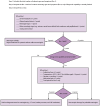CDC Guidelines for the Prevention and Treatment of Anthrax, 2023
- PMID: 37963097
- PMCID: PMC10651316
- DOI: 10.15585/mmwr.rr7206a1
CDC Guidelines for the Prevention and Treatment of Anthrax, 2023
Erratum in
-
Erratum: Vol. 72, No. RR-6.MMWR Morb Mortal Wkly Rep. 2024 Aug 8;73(31):689. doi: 10.15585/mmwr.mm7331a4. MMWR Morb Mortal Wkly Rep. 2024. PMID: 39116031 Free PMC article. No abstract available.
Abstract
This report updates previous cdc guidelines and recommendations on preferred prevention and treatment regimens regarding naturally occurring anthrax. also provided are a wide range of alternative regimens to first-line antimicrobial drugs for use if patients have contraindications or intolerances or after a wide-area aerosol release of: Bacillus anthracis spores if resources become limited or a multidrug-resistant B. anthracis strain is used (Hendricks KA, Wright ME, Shadomy SV, et al.; Workgroup on Anthrax Clinical Guidelines. Centers for Disease Control and Prevention expert panel meetings on prevention and treatment of anthrax in adults. Emerg Infect Dis 2014;20:e130687; Meaney-Delman D, Rasmussen SA, Beigi RH, et al. Prophylaxis and treatment of anthrax in pregnant women. Obstet Gynecol 2013;122:885-900; Bradley JS, Peacock G, Krug SE, et al. Pediatric anthrax clinical management. Pediatrics 2014;133:e1411-36). Specifically, this report updates antimicrobial drug and antitoxin use for both postexposure prophylaxis (PEP) and treatment from these previous guidelines best practices and is based on systematic reviews of the literature regarding 1) in vitro antimicrobial drug activity against B. anthracis; 2) in vivo antimicrobial drug efficacy for PEP and treatment; 3) in vivo and human antitoxin efficacy for PEP, treatment, or both; and 4) human survival after antimicrobial drug PEP and treatment of localized anthrax, systemic anthrax, and anthrax meningitis.
Changes from previous cdc guidelines and recommendations include an expanded list of alternative antimicrobial drugs to use when first-line antimicrobial drugs are contraindicated or not tolerated or after a bioterrorism event when first-line antimicrobial drugs are depleted or ineffective against a genetically engineered resistant: B. anthracis strain. In addition, these updated guidelines include new recommendations regarding special considerations for the diagnosis and treatment of anthrax meningitis, including comorbid, social, and clinical predictors of anthrax meningitis. The previously published CDC guidelines and recommendations described potentially beneficial critical care measures and clinical assessment tools and procedures for persons with anthrax, which have not changed and are not addressed in this update. In addition, no changes were made to the Advisory Committee on Immunization Practices recommendations for use of anthrax vaccine (Bower WA, Schiffer J, Atmar RL, et al. Use of anthrax vaccine in the United States: recommendations of the Advisory Committee on Immunization Practices, 2019. MMWR Recomm Rep 2019;68[No. RR-4]:1-14). The updated guidelines in this report can be used by health care providers to prevent and treat anthrax and guide emergency preparedness officials and planners as they develop and update plans for a wide-area aerosol release of B. anthracis.
Conflict of interest statement
All authors have completed and submitted the International Committee of Medical Journal Editors form for disclosure of potential conflicts of interest. CDC and contributors to this work disclose that they have no financial interests or other relationships with the manufacturers of commercial products, suppliers of commercial services, or commercial supporters that would unfairly influence these CDC recommendations with the following exceptions: Arthur Friedlander reports funding from the U.S. Department of Defense Threat Reduction Agency for research on anthrax vaccines and therapeutics. However, none of the vaccines or therapeutics were discussed for inclusion in the guidelines. Adolf W. Karchmer receives an honorarium for service on the data and safety monitoring board (tofacitinib) for Pfizer. Todd Semla’s spouse owns stock in Abbott. Both Pfizer and Abbott manufacture antimicrobial drugs included in the guidelines. No other potential conflicts of interest were disclosed.
Figures
References
-
- Blackburn JK, McNyset KM, Curtis A, Hugh-Jones ME. Modeling the geographic distribution of Bacillus anthracis, the causative agent of anthrax disease, for the contiguous United States using predictive ecological [corrected] niche modeling. Am J Trop Med Hyg 2007;77:1103–10. 10.4269/ajtmh.2007.77.1103 - DOI - PubMed
-
- Yang A, Mullins JC, Van Ert M, Bowen RA, Hadfield TL, Blackburn JK. Predicting the geographic distribution of the Bacillus anthracis A1.a/Western North American sub-lineage for the continental United States: new outbreaks, new genotypes, and new climate data. Am J Trop Med Hyg 2020;102:392–402. 10.4269/ajtmh.19-0191 - DOI - PMC - PubMed
MeSH terms
Substances
LinkOut - more resources
Full Text Sources
Medical
Research Materials
Miscellaneous

